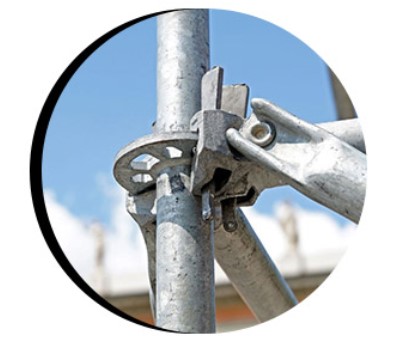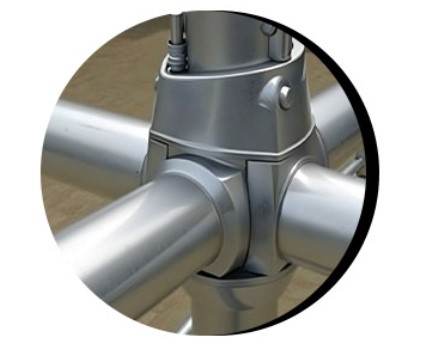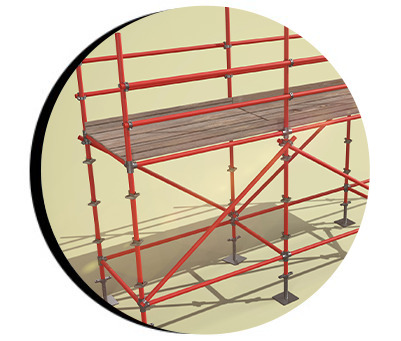Construction projects of all sizes demand efficiency, safety, and versatility, especially when working at height. This is where modular scaffolding systems come in.
Modular scaffolding has revolutionised the industry by offering customisable solutions that are both reliable and easy to use. Among the most popular types of modular scaffolding systems are ringlock, cuplock, and kwikstage. Each has its unique features, benefits, and applications.
This article will walk you through what modular scaffolding is, explore the distinct types, and help you determine which system is most compatible with your project’s specific needs.
What is modular scaffolding?

Modular scaffolding is a cutting-edge system designed for easy assembly, disassembly, and transport. Unlike traditional scaffolds, modular scaffolding uses pre-engineered, standardised main components that fit together seamlessly.
Key benefits of modular scaffolding
- Safety-first design: Modular scaffolding systems are engineered for exceptional safety, meeting stringent industry standards to ensure worker protection.
- Quick assembly: The modular design allows for faster assembly and disassembly, saving time, labour costs and allowing for easy storage.
- Lightweight materials: Made from durable yet lightweight materials like high-strength steel and aluminium, modular scaffolding is easy to transport and store.
- Versatility: Modular scaffolding can adapt to a wide range of projects, including construction, maintenance, and even events.
Ringlock scaffolding

Ringlock modular scaffolding is a revolutionary system known for its robust design and flexibility. It uses a rosette fixed to vertical standards, allowing for multiple connections at various angles.
Key features and benefits of ringlock scaffolding
- Fewer components: Ringlock scaffolding has a minimal number of components, reducing the complexity of transportation and assembly.
- 360-degree flexibility: The rosette node enables connections at various angles, making it ideal for complex structures.
- Durable and secure: Manufactured with high-grade steel, it boasts excellent strength and stability.
Popularity and common uses of ringlock scaffolding
Ringlock scaffolding is commonly used in Europe and North America thanks to its adaptability. It is a go-to choice for construction projects, industrial maintenance, and even staging setups for events. Whether it’s a bridge, high-rise building, or stage platform, ringlock scaffolding excels in challenging environments.
Cuplock scaffolding

Cuplock scaffolding is another highly efficient modular system, designed with a simple cup-and-blade locking mechanism. This system is especially renowned for its ease of assembly.
Key features and benefits of cuplock scaffolding
- Simple locking mechanism: The top cup slides easily over a blade connection, locking components securely in place.
- Time-saving assembly: The straightforward design allows workers to assemble and dismantle it quickly, speeding up construction timelines.
- Strong and versatile: Cuplock scaffolding can support heavy loads, making it suitable for various construction and industrial projects.
Popularity and common uses of cuplock scaffolding
Cuplock scaffolding enjoys immense popularity in Asia, where its efficiency and simplicity make it a preferred choice for large-scale infrastructure projects. It is well-suited for projects requiring heavy-duty support, including building exteriors, bridges, and industrial maintenance.
Kwikstage scaffolding

Kwikstage scaffolding is a modular system popular for its straightforward assembly and cost-effectiveness. It is particularly favoured in Australia and New Zealand.
Key features and benefits of kwikstage scaffolding
- Colour-coded components: The system uses distinct colour coding for easy visual identification, reducing assembly errors.
- Durability: Built to withstand tough environments, kwikstage scaffolding is a highly durable solution.
- User-friendly assembly: With minimal training, workers can assemble kwikstage scaffolding quickly and efficiently.
Popularity and common uses of kwikstage scaffolding
Kwikstage scaffolding thrives on construction sites across Australia and New Zealand, where its durability and simplicity make it invaluable. It’s perfect for residential and commercial construction projects, as well as restoration and refurbishment work.
Comparative analysis of each scaffolding system
Each type of modular scaffolding has its own strengths, making it essential to choose the system that best suits your project requirements.
| Feature | Ringlock | Cuplock | Kwikstage |
| Ease of assembly | Very quick | Quick | Very quick |
| Weight capacity | High | Very high | High |
| Complexity of design | Ideal for complex structures | Simple, versatile | Simple and straightforward |
| Best for | Bridges, high-rises, events | Heavy-duty projects | Residential and commercial |
| Popularity | Europe, North America | Asia | Australia, New Zealand |
System scaffold regional preferences
- Ringlock is globally recognised but particularly dominant in Europe and North America for its adaptability and strength.
- Cuplock remains a favourite in Asia due to its heavy-duty capability and versatility.
- Kwikstage is the go-to system in Australia and New Zealand, where its simplicity and durability shine.
Making the right choice
The right modular scaffolding system for your project depends on various factors, including the complexity of the structure, load-bearing requirements, and regional preferences. For instance:
- If you need maximum flexibility for a complex design, ringlock scaffolding is your best bet.
- For heavy-duty applications, cuplock scaffolding is a standout option.
- When simplicity and cost-effectiveness are key, kwikstage scaffolding excels.
FAQ
How do I ensure worker safety while using modular scaffolding?
To ensure worker safety, it is crucial to follow all local safety regulations and guidelines. Regularly inspect the scaffolding for wear and tear, ensure proper assembly according to manufacturer instructions, and provide workers with appropriate safety equipment, such as harnesses and helmets.
Can modular scaffolding be used for residential projects?
Yes, modular scaffolding systems are suitable for residential projects. They offer flexibility and adaptability to fit various building sizes and designs, making them an excellent option for tasks like painting, roofing, or home extensions.
How easy is it to transport modular scaffolding?
Modular scaffolding systems are designed to be lightweight and easy to dismantle, making transportation relatively simple. Many systems also have interchangeable components, reducing the need for specialised pieces and streamlining the logistics process.
Is it possible to rent modular scaffolding instead of purchasing it?
Yes, many companies offer modular scaffolding systems for rent. Renting can be a cost-effective option for short-term projects or if purchasing is not feasible due to budget constraints.
What maintenance is required for modular scaffolding?
Regular maintenance includes cleaning components after use, storing them in a dry, secure environment, and inspecting for any damage or corrosion before reassembly. Proper care ensures the longevity and safety of the scaffolding system.
Ready to get started with modular scaffolding?
Modular scaffolding continues to transform the construction industry, offering unmatched safety, efficiency, and adaptability. By choosing the right system for your needs, you can ensure smoother operations, reduced labour costs, and improved project outcomes.
At B-Mat Scaffolding, we pride ourselves on offering top-quality modular scaffolding solutions tailored to your specific requirements. Whether you’re looking for ringlock, cuplock, or kwikstage scaffolding, we’re here to help you make an informed choice that sets your project up for success.Get in touch with us today for expert advice and a free quote. Together, we’ll help build your next project with confidence and efficiency.


